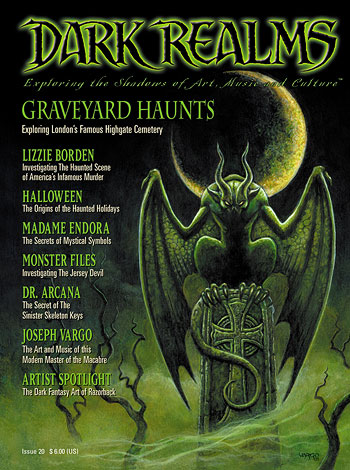
Dark Realms Magazine - Issue 20
Halloween: The Origins of the Haunted Holiday
October 31st, Halloween Night— when ghouls and goblins prowl the forests, witches take to flight on broomsticks and the dead rise from their graves to haunt the realm of the living. Halloween is one of America's most popular holidays, traditionally celebrated by trick-or-treating, lighting Jack-o-lanterns, and telling ghost stories by candlelight. However, the holiday evolved from age-old pagan rites that paid tribute to the dead, and echoes of many of these ancient customs survive to this day.
PAGAN ORIGINS
The modern association of Halloween with ghosts and spirits of the dead is derived from Celtic, Greek and Roman origins. The ancient Celtic festival of Samhain was celebrated on November 1, at the start of the Celtic winter season. On this evening, the souls of the dead were believed to rise from their graves to wreak havoc among the living. The Lord of the Dead would restore order on this night by condemning the evil spirits to spend the ensuing year in animal form. Good spirits, however, were pardoned and allowed to retain their human forms in the afterlife. In an effort to appease any troublesome spirits, the ancient Celts would set out offerings of food for them. The Celts would also don masks and other disguises in order to fool any wandering ghosts who might target specific living individuals. Both the concepts of food offerings and disguises survive in the modern rite of trick-or-treating. In addition, the Samhain festival included rituals of prophecy performed by the Celtic priests known as the Druids. These rituals were conducted by firelight, and even today bonfires are often held on Halloween night.
The ancient Greeks also held a festival associated with spirits of the dead in February or sometimes March. During this time, ghosts were said to plague the world of the living, causing mischief throughout Greek society. In order to protect themselves against the spirits, Greeks coated their doors with pitch and made offerings to the god Hermes, who would round up the ghosts and lead them back to Hades. Roman society, which borrowed extensively from Greek culture, echoed these practices in the festival of Lemuria, which was held in May. During Lemuria, evil spirits known as lemures would trouble the living, and Romans performed many superstitious rituals to ward off the lemures. One of the oddest rituals involved washing one's hands three times, then holding black beans in one's mouth while throwing other black beans on the floor for the ghosts to pick up. The spirits were believed to take the beans as a peace offering and would leave that particular household alone.
ALL HALLOW'S EVE
One of the methods by which the Christian Church was able to gain influence throughout the pagan world was by allowing the practices of pagan rituals and festivals, albeit in modified, Christianized form. The Church's All Saints' Day, which was established to commemorate Christian martyrs, was moved from May 13 to November 1 in the 8th century in order to coincide with (and, hopefully, to eventually replace) the festival of Samhain. Samhain animal sacrifices became replaced with prayers, and conventional food offerings were replaced by "soul cakes," which were often distributed to the poor who were then enlisted to pray for the dead. The poor would typically roam through their villages, asking for the soul cakes, a practice that would eventually metamorphose into trick-or-treating. It also became customary to play somewhat malicious tricks on those who did not give out the cakes—the "trick" part of trick-or-treating.
The night before All Saints' Day became known as All Hallows' Eve, an archaic name referring to the evening prior to the celebration of holy or hallowed saints. The word Halloween reflected a common English practice of both shortening and then contracting two words into one—in this case, "Hallows Evening." Like All Saints' Day, All Hallows' Eve became associated with the dead. In Britain, it was believed that spirits wandered the countryside on this night, led by ghostly dogs and sinister witches.
THE JACK-O-LANTERN
Halloween as we know it today owes much to the Irish immigrants who came to the US in the 19th century to flee the potato famine ravaging Ireland. The immigrants brought many of their customs with them, including their All Hallows' Eve and All Saints' Day rituals. One of these rituals has become the most familiar symbol of Halloween: the practice of putting a candle inside a hollowed-out pumpkin. This custom comes from an Irish folktale about an unsavory man named Jack who upon his death was denied entrance to both heaven and hell. In fact, the devil sent him away to wander the earth for eternity, giving Jack a lump of coal to use as a light source on his dark journey. Jack fashioned a crude lantern by putting the coal inside a hollowed-out turnip. Because pumpkins were plentiful in America, Irish immigrants began using them rather than turnips to create these symbols of Jack's lantern, which are now known as jack-o-lanterns. Over time, it also became customary to carve ferocious faces into the pumpkin.
A night steeped in supernatural beliefs and fears, Halloween is the amalgam of centuries of pagan and Christian customs that honor the dead and protect the living from evil spirits. In the modern world, it has become a celebration of ghosts, witches, monsters, vampires, fairies and goblins, and the holiday demonstrates the persistent human fascination with the mysterious world that lies beyond our earthly lives.

